
Food Safety Bulletin for Consumers 2013 (3rd Issue)
Knowledge on Hygienic Consumption of Bottled Water
 Bottled water is frequently consumed by most people. There are various kinds of bottled water produced locally and imported from different places of origin, including natural mineral water, distilled water and artificially mineralised water, available in the market.
Bottled water is frequently consumed by most people. There are various kinds of bottled water produced locally and imported from different places of origin, including natural mineral water, distilled water and artificially mineralised water, available in the market.
Consumers should note that they should choose bottled water that is suitable for them. For example:
- People with lower immunity should avoid bottled water that has not undergone a treatment process such as distillation or reverse osmosis. Water from carboys for water dispensers should be boiled before consuming. Advice from healthcare professionals should be sought if necessary.
- People taking care of infants should note that they should boil water from water dispensers if they use it for preparing infant formula. The temperature of water used for preparation should not be lower than 70oC. Prepared formula should then be cooled to feeding temperature and consumed immediately. Mineralised water is not suitable for preparing infant formula.
Advice for Consumers
-
Buy bottled water from reliable manufacturers or shops.
-
Check the expiry date and packaging of bottled water. Do not buy or consume any bottled water that is past its expiry date, or with damaged packaging or broken seal.
-
Once opened, bottled water should be consumed as soon as possible.
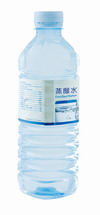
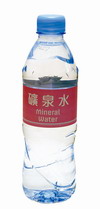
Readers' Corner
Food Safety Tips for Fruits and Fruit Products
Fruits are nutritious and an important part of a healthy diet. However, fresh fruits may be contaminated when they come into contact with harmful microorganisms (such as bacteria and viruses) that are present in the soil, water or animal faeces. Fruits and fruit products may also become contaminated during preparation or storage. Consuming contaminated fruits and fruit products can lead to illnesses. To ensure food safety, it is important to follow food safety tips below at all times, including when travelling abroad:
For Fresh Fruits Including Cut Fruits –
Purchase

- Purchase fresh fruits that are not damaged and bruised on the surface.
- Patronise hygienic and reliable shops and buy ready-to-eat cut fruits that are properly refrigerated only.
Storage
- Keep perishable fresh fruits like strawberries, as well as cut or peeled fresh fruits, at 4oC or below if they are not for immediate consumption. When carrying cut or peeled fresh fruits to a picnic or gathering outdoors, put them in an ice box/cooler bag and discard them if they are kept at room temperature for more than 4 hours (including time for preparation, storage and transportation).
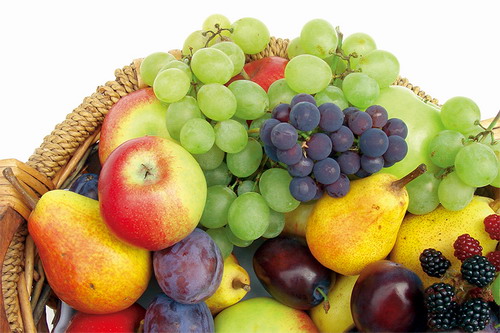
Preparation
-
Wash hands thoroughly before and after handling fresh fruits.
-
Cut away any bruised parts on fresh fruits before preparing and/or eating. Discard the whole fruit when it is rotten.
-
Wash fresh fruits (including their inedible skins and rinds) thoroughly under tap water to remove any dirt before peeling, cutting and eating. This serves to reduce microorganisms that may be present.
- Fruits with firm skin, e.g. melons, should be washed and rubbed under tap water or scrubbed with a clean fruit and vegetable brush.
- Do not wash fruits with soap or detergent.
- Dry fruits with a clean cloth or paper towel to further reduce microorganisms that may be present.
-
Use separate cutting boards and knives for ready-to-eat fresh fruits and raw foods (such as raw meat).
-
As fruit skin is a useful source of dietary fibre, in general it can be eaten where possible after thorough washing. However, to reduce the risk of illness, especially when travelling abroad, peel raw fruits before eating and do not eat the peelings.
- Fresh fruits of date palm should be peeled before consumption.
-
Cut or peeled fruits should be consumed as soon as possible. As a general rule, if cut or peeled fruits have been kept under room temperature:
- for less than 2 hours, they can be refrigerated for later use and should be consumed within the 4 hours limit. Cut or peeled fresh fruits kept in the refrigerator should be consumed within 1 to 2 days.
- for more than 2 hours but less than 4 hours, they should be consumed within the 4 hours limit and should not be returned to the refrigerator.
- for more than 4 hours, they should be discarded immediately.
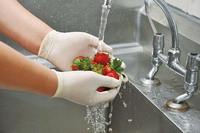
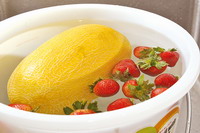
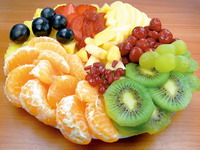
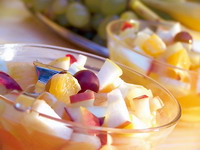
For Fruit Products Including Dried Fruits and Fruit Juices –
Purchase
- Buy fruit products from hygienic and reliable shops.
Storage
- Read and follow the storage instructions of fruit products, e.g. keep pasteurised juice at 4°C or below.
Use
-
Do not consume fruit products that are past their "best before" or "use by" date.
-
Do not consume fruit products if their packaging is torn or broken, or if the products have shown signs of deterioration (e.g. mouldy surface).
-
Fresh fruit juices may be contaminated with microorganisms that are present inside or outside the fresh fruits unless the juices are treated to destroy any harmful microorganisms.
-
Susceptible population groups (e.g. pregnant women, infants, young children, the elderly and people with weakened immune systems) should avoid high risk food including untreated fruit juices and salad made from fresh fruits.
-
Juice extracted from freshly collected fruits of date palm should be boiled before consumption.
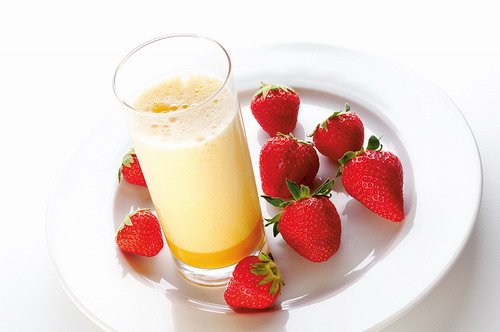
Maleic Acid in Food
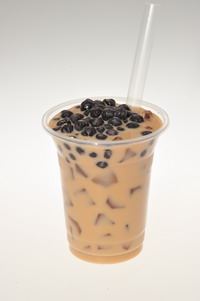 Maleic acid, as well as its related chemical, maleic anhydride, are multi-functional chemical intermediates with many industrial applications and can be used in food contact materials (FCMs). Maleic acid can also be used as a precursor for the production of food additives. Maleic anhydride readily converts to maleic acid in contact with water, and its level of concentration is often expressed as maleic acid during food testing. As maleic acid can be used in producing FCMs, it may migrate from FCMs to food when they come into contact. Besides, food additives used for food production may contain maleic acid as an impurity. Therefore, members of the public may be exposed to maleic acid at low levels through diet. According to the investigation by the Taiwan authorities, the food incident has been linked to the abusive use of maleic anhydride during the production of edible modified starch, which was subsequently used for food production.
Maleic acid, as well as its related chemical, maleic anhydride, are multi-functional chemical intermediates with many industrial applications and can be used in food contact materials (FCMs). Maleic acid can also be used as a precursor for the production of food additives. Maleic anhydride readily converts to maleic acid in contact with water, and its level of concentration is often expressed as maleic acid during food testing. As maleic acid can be used in producing FCMs, it may migrate from FCMs to food when they come into contact. Besides, food additives used for food production may contain maleic acid as an impurity. Therefore, members of the public may be exposed to maleic acid at low levels through diet. According to the investigation by the Taiwan authorities, the food incident has been linked to the abusive use of maleic anhydride during the production of edible modified starch, which was subsequently used for food production.
Animal studies have shown that maleic acid is not genotoxic, and is negative for reproductive and developmental toxicity. Despite the relatively low acute toxicity of maleic acid by the oral route, renal impairment has been observed in experimental animals being fed with high doses of maleic anhydride. The risk of adverse health effects (e.g. kidney damage) on humans due to consumption of large quantities of food containing maleic acid over long period cannot be totally excluded. The Centre for Food Safety (CFS) has conducted risk assessments regarding the levels of maleic acid detected by the Taiwan authorities and concluded that occasional consumption of those food products would not cause adverse health effects to the general public.
The CFS has notified the trade of the incident through its alert systems and has also informed traders and members of the public by way of the Food Incident Post on its website.
Both maleic acid and maleic anhydride should not be used as food additives. The public are advised to buy food from reliable shops.
Tips for Getting the Temperature Right
Thaw frozen food properly before cooking with the following methods where appropriate. Put the food:
- in the microwave oven;
- in the freezer of the refrigerator; or
- under running tap water.
Answers: (a ~ iv) / (b ~ v) / (c ~ i) / (d ~ ii) / (e ~ iii)
News on New Dishes
Rendang Sapi
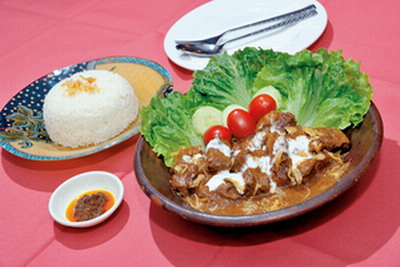 The Food Safety Plan is not only applicable to Chinese and Western cuisines but also to South East Asian delicacies. In this issue, we are honoured to have invited Chef LUI Tai-tat and Chef HA Ting-kiu of Nyonya Indocook House, a signatory of the Food Safety Charter in the Tuen Mun District, to demonstrate how to prepare the highly popular Indonesian dish "Rendang Sapi".
The Food Safety Plan is not only applicable to Chinese and Western cuisines but also to South East Asian delicacies. In this issue, we are honoured to have invited Chef LUI Tai-tat and Chef HA Ting-kiu of Nyonya Indocook House, a signatory of the Food Safety Charter in the Tuen Mun District, to demonstrate how to prepare the highly popular Indonesian dish "Rendang Sapi".
| Preparation Steps | Small Tips, Big Wisdom | ||
|---|---|---|---|
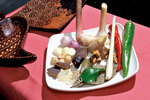 |
Receiving | First, purchase frozen beef and other ingredients such as spices and coconut milk from approved and reliable sources. | Upon receipt of the ingredients, check with meticulous care to ensure their freshness. Frozen beef should be stored in a refrigerator at -18oC or below. Spices and coconut milk should also be stored properly. |
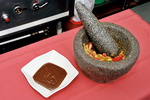 |
Preparing the sauce | Grind various fresh spices with seasoning and set aside. | The spices are freshly ground every time to achieve perfect colour, aroma and taste. |
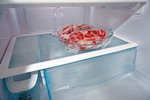 |
Defrosting | Defrost frozen beef in a refrigerator at 4oC or below. | Defrosting in a refrigerator at 4oC or below not only ensures food safety but also keeps the fresh taste of beef. |
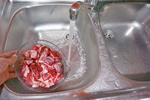 |
Rinsing | Rinse beef thoroughly with water and remove any excess fat. | Remove surface impurities and any excess fat to improve the texture. |
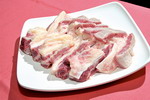 |
Cutting / Blanching | Cut the beef into chunks and blanch them in boiling water for 1 to 2 minutes. Drain and set aside. After blanching, cut the beef chunks into cubes. | Blanching can remove the frozen taste and smell of blood. It can also help maintain the shape of the beef, making it easier to cut the beef chunks into cubes for a better appearance. |
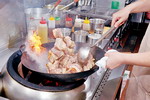 |
Stir-frying | Heat beef fat in wok. Add blanched beef cubes and stir-fry with sauce until fragrant. | Brisk stir-frying in wok makes ingredients taste better. |
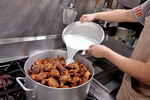 |
Stewing | Add coconut milk and stew beef over low heat for 20 to 25 minutes. Turn off the heat after covering the pot with a lid. Let beef sit in pot until tender and the temperature should be kept above 60oC during the process. | Beef only needs to be stewed for 20 to 25 minutes. After that, the residual heat in the pot will slowly make the beef tender, enabling it to absorb the flavours more easily. |
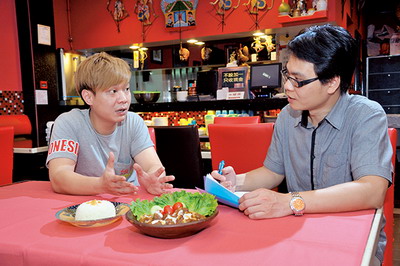
Tips from Chef LUI:
- Among Indonesian dishes, Rendang Sapi is cooked with relatively more spices. The spices and ingredients chosen for the dish should be fresh. Upon receipt of the spices, store them properly to avoid the loss of aroma.
- The beef cubes should not be too small in size or they will fall apart when cooked. Cut the beef across the grain to make it tenderer after cooking.
- When heating beef fat in wok, add a little water and salt so that oil will be released more easily.
- Hong Kong people are busy with their work. To save time, prepare more servings at one time. Let the beef cool down before keeping it in the refrigerator for later use. Take an appropriate portion of beef when needed and stew again for 10 to 15 minutes before serving.
Food Safety Plan Corner
Rendang Sapi
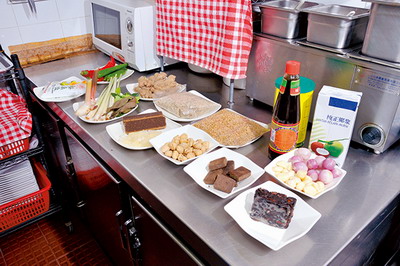
Ingredients:
Beef (flank or shank) and coconut milk
Seasoning:
Salt, sugar, light soy sauce, dark soy sauce and chicken powder
Ingredients of the Sauce for Rendang Sapi:
Coriander seeds, fennel seeds, candlenuts, tamarinds, salam leaves, kaffir lime leaves, lemon grass, turmeric, galangal, ginger, garlic, shallots, fresh chillies, shrimp paste, brown sugar and rock sugar
Steps:
- Defrost frozen beef in a refrigerator at 4oC or below.
- After defrosting, rinse the beef with water and cut into chunks. Blanch the beef chunks before cutting them into cubes.
- Add spice sauce to beef and stir-fry in wok until fragrant.
- Add coconut milk and stew beef for 20 to 25 minutes. Turn off the heat after covering the pot with a lid. Let the beef sit in the residual heat until tender and the temperature should be kept above 60 oC during the process.

Briefing of Activities
Food Safety Seminar for Trade
The Food Safety Seminar for Trade organised by the CFS was held on 16 September 2013. It aims to provide a platform for the trade and the Government to communicate and exchange views on the current important food safety issues in Hong Kong. Through the Seminar, we aim to achieve the following objectives:
- To provide a brief on the latest regulatory requirements and guidelines on food safety in Hong Kong;
- To introduce new food safety initiatives and programmes on food safety;
- To promote safe food practices, including the "Five Keys to Food Safety", "Reduction of Intakes of Fat, Salt and Sugar", etc.; and
- To promote the importance of tripartite collaboration among the food trade, the public and the Government to ensure food safety
For the topics and programmes of the Seminar, please visit the website of the CFS (http://www.cfs.gov.hk).
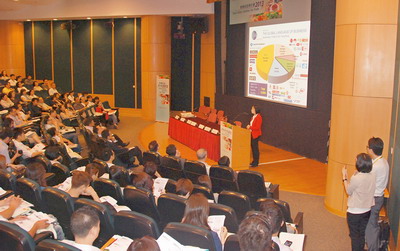
Trade Consultation Forum
To strengthen collaboration with the food trade and enhance food safety, the CFS regularly conducts the Trade Consultation Forum. The Forum provides a platform for the CFS to exchange views on food safety matters with the trade, discuss food safety control measures, as well as collect their feedback on risk communication activities. At the thirty-eighth meeting held on 11 January 2013, the CFS briefed the trade on the results of the Study on Trans Fatty Acids in Local Foods, the metallic contaminants in diet and the incident of Benzo[a]pyrene being found in cooking oil. Registration and record keeping requirements under the Food Safety Ordinance as well as the "Legislative Proposals Relating to Formula Products and Foods Intended for Infants and Young Children under the Age of 36 Months in Hong Kong" were also introduced to the attendees.
The thirty-ninth meeting of the Trade Consultation Forum was held on 7 March 2013. At the meeting, the CFS continued its discussion with the trade on the "Legislative Proposals relating to Formula Products and Foods Intended for Infants and Young Children under the Age of 36 Months in Hong Kong" and gave a brief explanation on the definition of powdered formula under the newly revised Import and Export (General) (Amendment) Regulation. The meeting also covered the measures adopted by Hong Kong on the partial relaxation of the restriction on the import of US beef, the Guidelines on Voluntary Labelling of Genetically Modified (GM) Food, the safety of GM foods and safety concerns on raw dairy products.
Details of the discussions at the meetings can be found on the following webpage:
http://www.cfs.gov.hk/english/committee/committee_tcf.htm
Food Safety Q&A
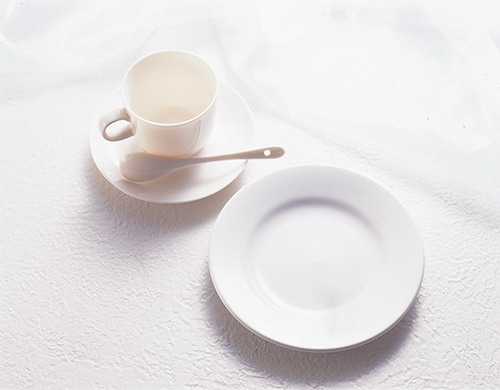
Q: Is there any regulatory control of the use of food contact materials (FCMs) in Hong Kong?
A: The safety of consumer goods including tableware, kitchen utensils and food containers ordinarily supplied for private use or consumption in Hong Kong is regulated under the Consumer Goods Safety Ordinance (CGSO) (Cap. 456), which is enforced by the Customs and Excise Department (C&ED). Under the CGSO, it is an offence for a person to import, manufacture or supply consumer goods unless the consumer goods comply with the general safety requirement. The C&ED continuously monitors the safety of consumer goods supplied on the local market so as to ensure that they are reasonably safe.
The safety of food utensils used by local food businesses is overseen by the Food and Environmental Hygiene Department. According to the Food Business Regulation under the Public Health and Municipal Services Ordinance (PHMSO) (Cap.132), every person who carries on any food business shall ensure that all equipment and utensils are kept clean and free from noxious matters.
Moreover, the PHMSO stipulates that all food for sale in Hong Kong must be fit for human consumption. Should the food be rendered unfit for human consumption due to contamination by FCMs, the sale of such food would be an offence.
Truth against Fallacy
Fruit Juices Are Healthier Than Soft Drinks
In summer, many people prefer to have cold drinks. When it comes to choosing beverages, many people will opt for fruit juices, thinking that they are healthier than other kinds of drinks. Unfortunately, this may be a trap in disguise.
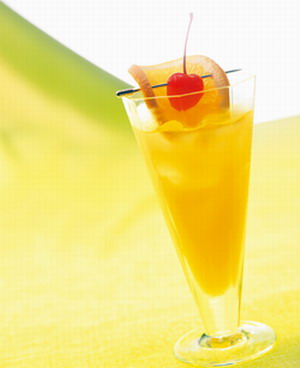 While some products, like fruit juices, carry the claim of having no added sugar, they may themselves contain a certain amount of sugar. Therefore, when selecting drinks, we should read the nutrition labels on the packages of different products for their sugar contents. In general, on nutrition labels of drinks, the reference amounts are expressed as per 100 ml or per serving. When looking for the sugar content shown on the nutrition label, we should pay attention to the reference amount first. Sometimes, we may do some simple calculations when necessary.
While some products, like fruit juices, carry the claim of having no added sugar, they may themselves contain a certain amount of sugar. Therefore, when selecting drinks, we should read the nutrition labels on the packages of different products for their sugar contents. In general, on nutrition labels of drinks, the reference amounts are expressed as per 100 ml or per serving. When looking for the sugar content shown on the nutrition label, we should pay attention to the reference amount first. Sometimes, we may do some simple calculations when necessary.
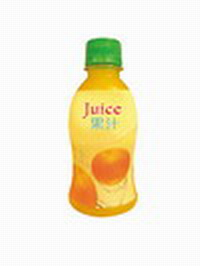
For Example:
On a bottle of 250 ml orange juice of a specific brand, its nutrition label shows that the sugar content per 100 ml is 10 g. Having consumed the whole bottle means taking in 25 g of sugar (10 g × 2.5), which is equivalent to half of the daily maximum intake for an ordinary person (based on a daily diet of 2 000 kilocalories, an ordinary individual should limit the intake of sugar to no more than 50 g per day (i.e. about 10 sugar cubes)).
Excessive intake of sugar can lead to overweight and obesity, which in turn will increase the risk of developing cardiovascular diseases, type-2 diabetes and certain types of cancers.
Since the intake of sugar is related to the amount of consumption, never consider fruit juices as healthier choices and consume in abundance.
Upcoming Activities
Roving Exhibitions on Food Safety
The CFS holds a series of exhibitions on specific themes in major shopping centres of public and private housing estates in different districts across the territory every year. Exhibition panels covering various topics such as food safety and nutrition are displayed and educational videos are shown to enhance public knowledge on making safe and suitable food choices. Please visit the CFS website (www.cfs.gov.hk) for regular updates on the exhibitions.
Brain Gym
Match the regulations/ordinance on the left with the correct descriptions on the right.
| (a) | Preservatives in Food Regulation | (i) | Applicable to general prepackaged foods | |
| (b) | Food Business Regulation | (ii) | Including a registration scheme for food importers and food distributors | |
| (c) | Food and Drugs (Composition and Labelling) Regulations | (iii) | Prohibiting import and sale of fish, meat or milk etc. containing prohibited substances | |
| (d) | Food Safety Ordinance | (iv) | Listing food additives permitted for specific foods and the description and proportion of food additive in each case | |
| (e) | Harmful Substances in Food Regulations | (v) | Containing provisions that regulate food premises |
(Answers can be found on page 5.)
Enquiry and Subscription
Printed copies of the Food Safety Bulletin can be collected at the Communication Resource Unit located at 8/F, Fa Yuen Street Municipal Services Building, 123A Fa Yuen Street, Mong Kok, Kowloon. For enquiry, please call 2381 6096. The public may also visit the website of the CFS ( http://www.cfs.gov.hk) for the online version.